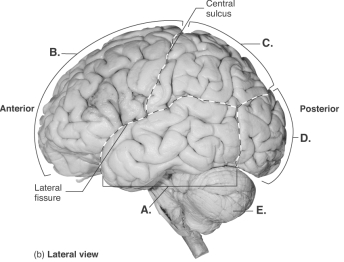A) cerebrum
B) cerebellum
C) corpus callosum
D) diencephalon
E) brainstem
Correct Answer

verified
A
Correct Answer
verified
Multiple Choice
Which of the following is a function of the hypothalamus?
A) initiates voluntary movements
B) involved in psychosomatic illnesses
C) control of balance
D) unconscious swinging of the arms while walking
E) perception of sensation
Correct Answer

verified
B
Correct Answer
verified
Multiple Choice
The basal nuclei function to
A) produce stiff,exaggerated movements.
B) assist the autonomic nervous system.
C) inhibit unwanted muscular activity.
D) control alertness.
E) store memory.
Correct Answer

verified
C
Correct Answer
verified
Multiple Choice
Which of the following arteries supply blood to the brain?
A) external carotid arteries
B) internal carotid arteries
C) vertebral arteries
D) Both the internal carotid arteries and the vertebral arteries.
Correct Answer

verified
Correct Answer
verified
Multiple Choice
A deer hunter lost the hearing in his right ear after his gun exploded when he tried firing it.His hearing loss is the result of damage to what nerve?
A) vagus
B) hypoglossal
C) glossopharyngeal
D) trigeminal
E) vestibulocochlear
Correct Answer

verified
Correct Answer
verified
Multiple Choice
Motor control of the face is the function of the ____ nerve,while sensation from the face is determined by the ____ nerve.
A) facial,trigeminal
B) trochlear,facial
C) facial,glossopharyngeal
D) trigeminal,glossopharyngeal
E) trigeminal,facial
Correct Answer

verified
Correct Answer
verified
Multiple Choice
 -This is a lateral view of the brain.What does "E" represent?
-This is a lateral view of the brain.What does "E" represent?
A) temporal lobe
B) cerebellum
C) frontal lobe
D) occipital lobe
E) parietal lobe
Correct Answer

verified
Correct Answer
verified
Multiple Choice
The pyramids of the medulla contain
A) ascending motor tracts.
B) descending motor tracts.
C) ascending sensory tracts.
D) descending sensory tracts.
E) None of these choices are correct.
Correct Answer

verified
Correct Answer
verified
Multiple Choice
Dysfunction of the sternocleidomastoid muscle could result from damage to the
A) vagus nerve.
B) abducens nerve.
C) accessory nerve.
D) hypoglossal nerve.
E) facial nerve.
Correct Answer

verified
Correct Answer
verified
Multiple Choice
The habenular nuclei and pineal body are both found in the
A) thalamus.
B) epithalamus.
C) hypothalamus.
D) subthalamus.
E) hyperthalamus.
Correct Answer

verified
Correct Answer
verified
Multiple Choice
Which of the following cranial nerves is exclusively sensory?
A) vestibulocochlear (VIII)
B) hypoglossal (XII)
C) trochlear (IV)
D) facial (VI)
E) trigeminal (V)
Correct Answer

verified
Correct Answer
verified
Multiple Choice
A bird hits the windshield of your car,and you reflexively duck and close your eyes.Which of the following is responsible for this action?
A) medulla
B) superior colliculi
C) reticular formation
D) thalamus
E) cerebellum
Correct Answer

verified
Correct Answer
verified
Multiple Choice
The Roman numerals assigned to each cranial nerve reflect
A) the order of their discovery.
B) the sequence from anterior to posterior in which they emerge from the brain.
C) their importance,with highest numbers being the most important.
D) the complexity of each nerve,with complex nerves having higher numbers.
E) the sequence from posterior to anterior in which they emerge from the brain.
Correct Answer

verified
Correct Answer
verified
Multiple Choice
The lateral fissure separates the _____ from the rest of the cerebrum.
A) frontal lobe
B) parietal lobe
C) occipital lobe
D) temporal lobe
E) cerebellum
Correct Answer

verified
Correct Answer
verified
Multiple Choice
 -This is a lateral view of the brain.What does "C" represent?
-This is a lateral view of the brain.What does "C" represent?
A) temporal lobe
B) cerebellum
C) frontal lobe
D) occipital lobe
E) parietal lobe
Correct Answer

verified
Correct Answer
verified
Multiple Choice
Dentists anesthetize a portion of the _____ nerve to stop pain impulses from the teeth.
A) facial
B) trigeminal
C) hypoglossal
D) glossopharyngeal
E) abducens
Correct Answer

verified
Correct Answer
verified
Multiple Choice
The fact that the right side of the brain controls the left side of the body is explained by the
A) division of the cerebrum into two hemispheres.
B) division of the cerebellum into two hemispheres.
C) decussation of the pyramids in the medulla.
D) need for contra-lateral control of body function.
E) brainstem being below the midbrain.
Correct Answer

verified
Correct Answer
verified
Multiple Choice
The corpus striatum is composed of the
A) subthalamic and red nuclei.
B) lentiform and caudate nuclei.
C) caudate nucleus and substantia nigra.
D) substantia nigra and hippocampus.
E) subthalamic nuclei and pineal body.
Correct Answer

verified
Correct Answer
verified
Multiple Choice
The portion of the cerebellum that is involved in balance and eye movements is the
A) vermis.
B) flocculonodular lobe.
C) cerebellar peduncles.
D) arbor vitae.
E) lateral hemisphere.
Correct Answer

verified
Correct Answer
verified
Multiple Choice
If an animal has had its cerebrum removed,it cannot
A) see.
B) live.
C) breathe.
D) regulate body temperature.
E) regulate heart rate.
Correct Answer

verified
Correct Answer
verified
Showing 1 - 20 of 146
Related Exams